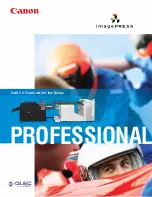
TwinSide TS™
Thermal Printer Family
HENGSTLER
Part No. D 691 023A
Mod. No. 4 120912 LEV
page 18 of 34
®
confidential, or the printout can be redeemed for cash or items of value. This function
can also be used to prevent the host from sending a new print job until the printout
from the previous print job has been removed.
Additionally, the chute sensor is monitored while first printing after a cut. After a cut,
the printer “knows” where the end of the paper is. As printing takes place, the printer
also “knows” how many paper advance steps have been made, and approximately
when the end of the paper should reach the chute sensor. If the paper does not
reach the sensor when expected, the printer assumes that a paper jam has taken
place and signals this fact via the Status command.
Please note that the chute sensor is not used when the printer is supplied equipped
with a presenter. In this case, the presenter entry sensor serves a similar function,
plus provides additional functionality related to the presenter.
2.6. Graphic Printing vs. Printing with Printer’s Fonts
One area that causes frequent confusion with regard to printers in general is that of graphic
printing versus printing using the printer’s internal fonts. An explanation here may help clarify
this and make application of the TwinSide TS™ easier for you.
All printers contain a set of commands that will cause the printer to perform different
functions. (For the TwinSide TS™ family of thermal printers, these commands are
documented in the TwinSide TS™ Emulation Command Set Reference, P/N D 691 010.) The
functions are very diverse and there are no standards for what these functions may be. This
allows printer manufacturers to innovate and build unique features into their products. These
commands are often referred to as the printer’s “Native Commands”.
A printer’s Native Commands are of many different types, but a few are of particular interest
to us here. One is the family of commands for printing graphics. It is these commands that
allow pictures and other graphic images of any type to be printed.
Another family of commands of interest to us here is the text commands. These commands
involve printing text in response to ASCII data sent to the printer. The printer itself contains
one or more character sets. In these character sets, one printable character corresponds to
one ASCII character. There are also commands for positioning and modifying the printout
from these character sets, such as tab and indent commands and commands to enlarge the
internal character set by some factor.
When printing from the internal character sets (we’ll call that “ASCII printing” here for
convenience), characters are sent to the printer and the corresponding characters from the
character set are printed. This has both advantages and disadvantages. The biggest
advantage is that the host need only send one character per printed character. So if 40
characters are being printed on a line, for example, only 40 bytes of data (plus any overhead
for formatting, indenting, etc.) need be transmitted over the interface. In other words, you can
print a lot of text and need send only a little data. The downside is a lack of flexibility. In
today’s Windows
®
world, we are all used to printing exactly what we see on our computer
screens, in the same font, size, etc. as we see it. But with ASCII printing, what will be printed
will be based on the printer’s internal character set.
The other type of printing we’ll call “Graphic printing”. This is what happens when you print to
an ink jet or laser printer from your PC. The information displayed on the screen is sent to a
print driver. This print driver, which is unique for each printer, translates what is on the screen
as a graphic into graphic Native Commands to be sent to the printer.
Everything printed
through a print driver prints as graphics
. It takes a lot more data to transmit graphics than
to transmit ASCII. In our 40 character example, assuming a 12 x 20 pixel character, the
Hengstler TS-56 printer would require 1,600 bytes to print one line. (Please note that these
are estimates, and that various compression routines also impact the print speed.)
















































